“The artist does nothing that others deem beautiful, but rather only what to him is a necessity.”
Arnold Schönberg, Harmonielehre
Arnold Schönberg is an autodidact. For a short time he received instruction in composition from Alexander von Zemlinsky, but not so much by way of lessons as by friendly discussions.
Nevertheless his works demonstrate the phenomenally high level of his ability and, in a marvelous way, his Harmonielehre proclaims to the world the incredible wealth of his knowledge.
The virtuosity of his ability has even been acknowledged by his opponents. They have spoken about his works as if they were theoretical speculations. They have called him a theoretician. The unprecedented art of his counterpoint has even been the subject of reproach.
But theory does not bring you any closer to his works. There is only one thing that is necessary: your heart must remain open. Schönberg’s work should be listened to without inhibition or prejudice of any kind. Put theory and philosophy aside. In Schönberg’s work there is purely music, music as in the case of Beethoven and Mahler. The experiences of his heart become tones. Schönberg’s relationship to art is rooted exclusively in the necessity for expression. His emotion is that of scorching flames; it creates completely new standards of expression, thus it needs entirely new means of expression. Content and form are inseparable.
The first-large scale work that Schönberg gave the world is the String Sextet Op. 4, Verklärte Nacht. The poem by Richard Dehmel precedes the score. Schönberg is one of the few who turned to chamber music at a time when Wagner’s music dramas served almost exclusively as a model for German composers, and almost everyone sought to express himself in the form of opera and larger orchestral works. However, he trod this ground not by following the classical path of Johannes Brahms, but rather by way of Richard Wagner.
The sextet is in one movement, the form of the movement freely improvised. The excessive wealth of themes and their variations immediately reveal Schönberg’s great art. In the brevity of its themes, the unrestricted way they succceed one another, and the free structure that results, the Sextet anticipates Schönberg’s works today. Its new tonal and harmonic effects surpass anything written at the time. It is a miracle of sound and without prototype in chamber music. I will cite from it a theme that already contains the seed of all the features so characteristic of Schönberg’s tonality.
»Der Künstler tut nichts, was andere für schön halten, sondern nur, was ihm notwendig ist.«
Arnold Schönberg, Harmonielehre.
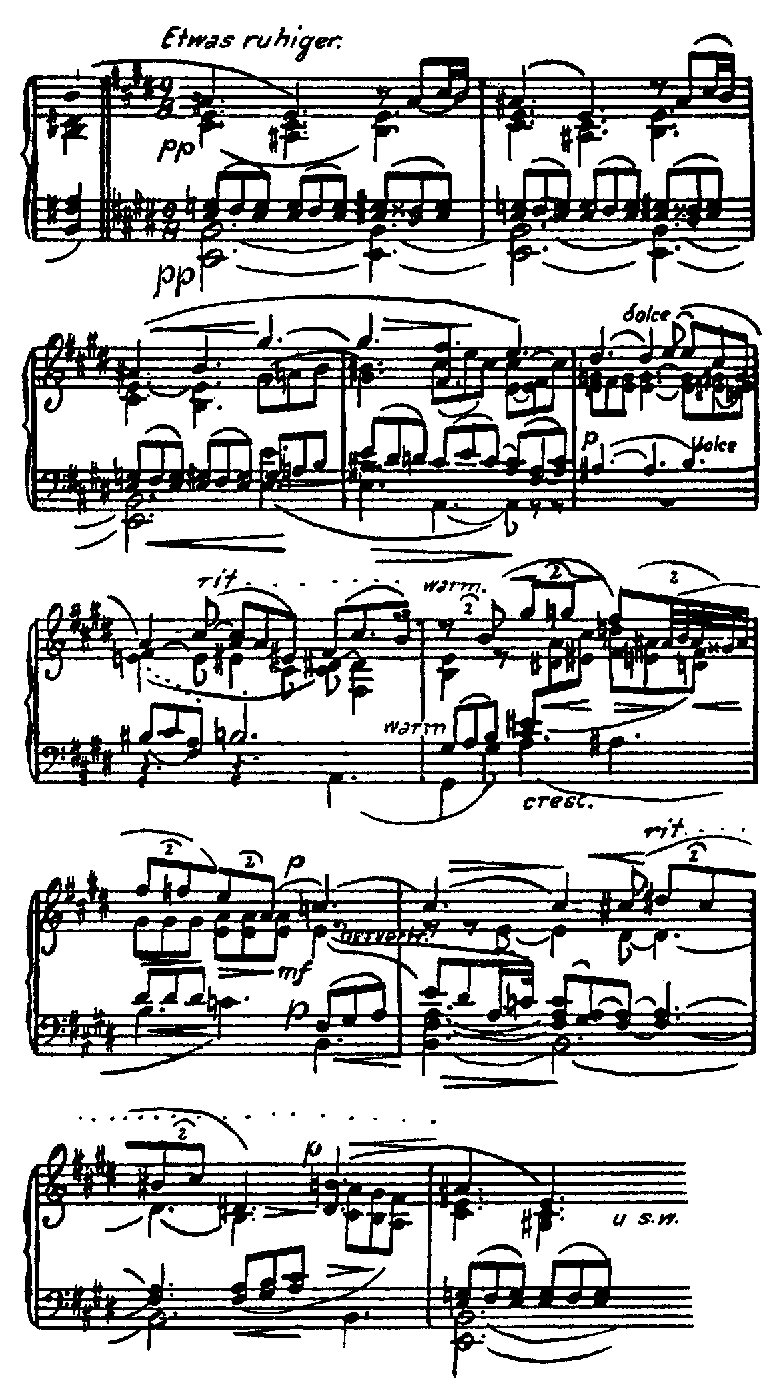
Nonharmonic tones, chromatic progressions clearly point in the direction of ever-progressing, and ultimately complete separation from tonality, as in Schönberg’s recent works. In addition, there is the freely suspended rhythm for which the barline is of absolutely no consequence. The Sextet was played for the first time in Vienna by the Arnold Rosé Quartet. Since then it has been given repeated performances in cities around Germany and Austria.
Similarly revolutionary are the songs that precede the Sextet, Opp. 1, 2, and 3, with poems by Levetzow, Dehmel, Schlaf, Keller; Jacobsen, Lingg, and from the Knaben Wunderhorn. Schönberg’s songs are far removed from declamatory and pictorial intention. They are songs in the style of Schubert, Schumann, or Mahler, and are thoroughly imbued with Schönberg’s astonishingly expressive melodic style.
Closely following the Sextet are the Gurrelieder after poems by J. P. Jacobsen. The work breaks up into three completely self-contained parts and is for large orchestra, soloists, three four-part men’s choruses, and, at the conclusion of the work, a mixed chorus. In addition, preceding the final chorus there is an episode of melodrama with a speaker.
Gurrelieder is scored for the following forces: 8 flutes (piccolos), 5 oboes (English horns), 7 clarinets, 5 bassoons (contrabassoon), 10 horns (Wagner tubas), and, in addition, 6 kettle drums, several timpani, 4 harps, celesta, and as large a string section as possible.
Schönberg wrote this work in 1900 and to date it has not been given a complete performance. The first part alone was performed in Vienna in 1909 (!) with piano (!!). It is the foremost duty of those who are in a position to do so, to see to it that this work be given a worthy performance. It makes great demands, but similar tasks have been accomplished before; why not in this instance?
The individual songs of each section are self contained compositions, but are connected by way of symphonic interludes which lead into one another.
I will cite a theme from the Gurrelieder in order to pursue further the path of Schönberg’s melodic style:
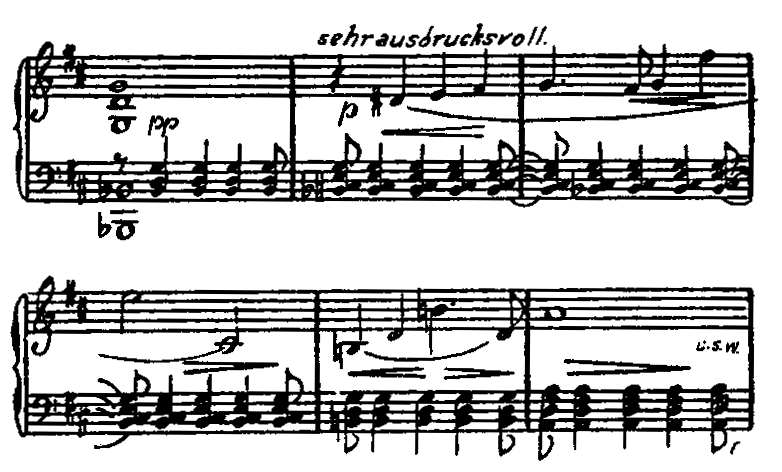
Especially noticeable are the wide intervals so prevalent in Schönberg’s music.
The four songs of Waldemar’s men in the third section, sung by three male choruses, are remarkably elaborate and use entirely novel sound effects. The poem following the last of these, which concludes the work, is entitled The Summer Wind’s Wild Hunt. It was shaped by Schönberg as follows: After a longer orchestral interlude, a speaker accompanied by the orchestra recites the poem in a slow, singing intonation until the words See the sun!; from this point an the mixed chorus takes over from the speaker with eight insertions of See! The effect of this choral entry is indescribable. The chorus which then follows and concludes the work is one of overwhelming beauty. As harmonic Support a wonderfully expressive male chorus together with first and second soprano, alto and half of the first tenors, execute a double canon. The two simultaneously entering themes are the following:
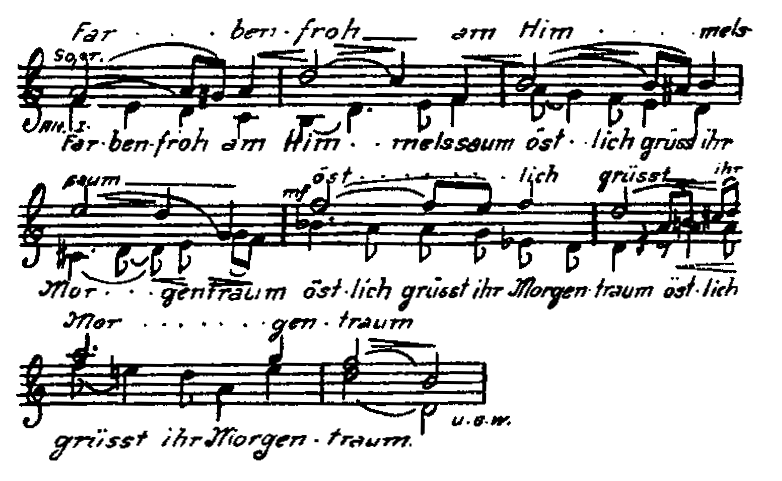
In the first quarter of the second measure the second alto and the first tenor enter. Who could possibly shut himself off from the beauty of this music!
This part is performed by a small group of individual voices. It is followed by an entirely canonic, imitative passage of extreme rapture for all the choral forces.
The instrumentation of Gurrelieder creates the most colossal effect. One need only imagine the sensitivity to sound as expressed in Schönberg’s Sextet carried over into the enormous apparatus of this orchestra to get an idea of the grandeur and richness of this instrumentation.
Gurrelieder are followed by the symphonic poem Pelleas and Melisande, hased an the drama of Maurice Maeterlinck (composed in Berlin in 1902). The instrumentation: 4 flutes (piccolos), 4 oboes (English horn), 4 bassoons (contrabassoon), 8 horns, 4 trumpets, 5 trombones, contrabasstuba, timpani, 2 harps, 32 violins, 12 each of violas and Cellos, 8 contrabasses.
This instrumental work by Schönberg is also in one movement. It lasts almost one hour. Its structure is quite free. It has a gigantic number of themes. They are for the most part short and improvisational – with the exception of a scherzo-like theme and a long, spunout Adagio – and are most artfully manipulated.
The richness of these modulations and variations is boundless. Each theme shows itself in a thousand shapes. The range of interpretation in Schönberg’s art is immeasurable. The instrumentation of this work is of a wonderful pathos and full of heretofore unknown colors.
I will cite two themes from Pelleas, in order to show how new they are with regard to harmony and melody, and how very much the tonal element of this music has slipped into the background.
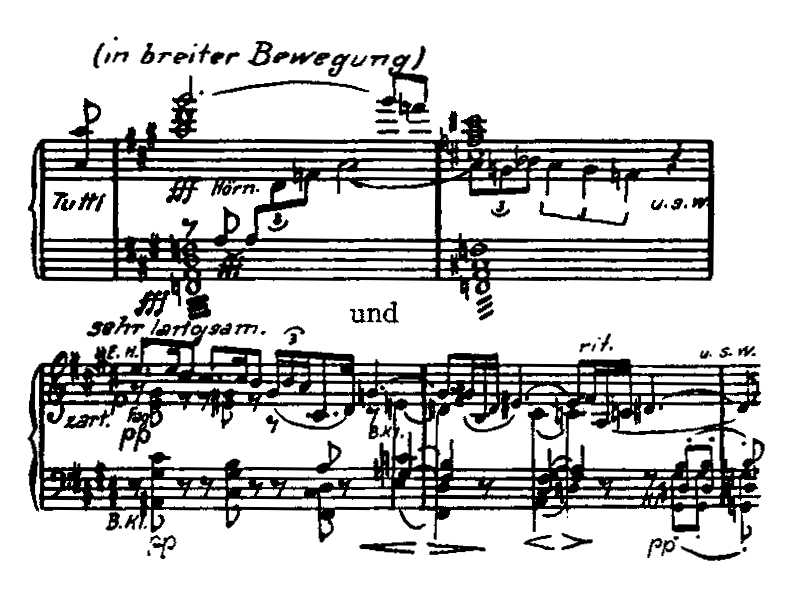
In "Pelleas", Schönberg is one of the first to utilize the whole-tone scale and the chords that are based on it. I cite a section where these are represented in a series of major thirds.
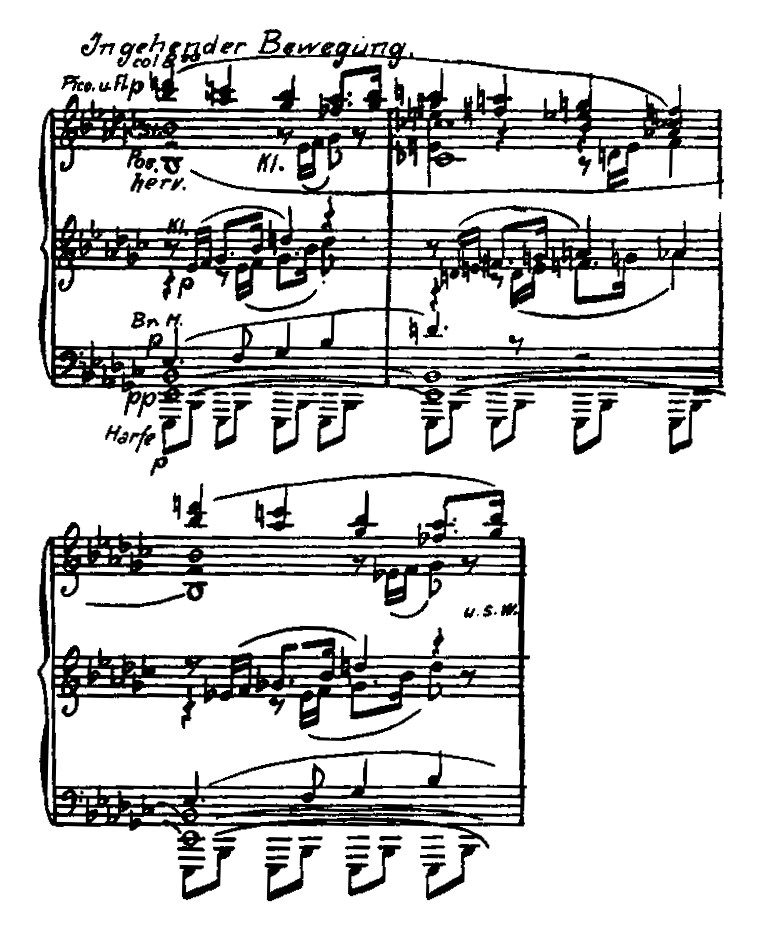
Now I relate a fact that shows how Schönberg accomplishes his harmonic conquests following nothing other than his immediate inspiration: in only one instance in Pelleas, in the following two measures, do we find one of the fourth chords (indicated by * in the example) that Schönberg uses much later in the Chamber Symphony, Op. 9, where they were recently given conscious shape for the first time.
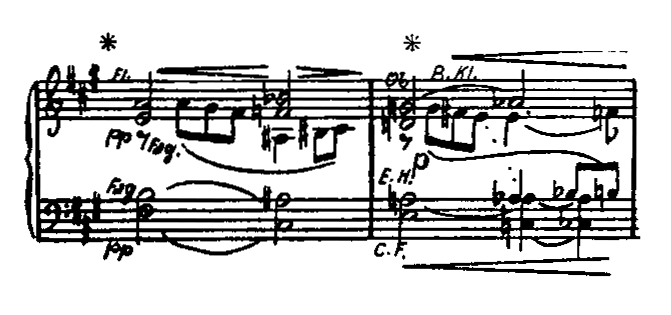
"Pelleas" was performed for the first time in Vienna in January 1905, with Schönberg conducting, at a concert of the Society of Creative Composers. The work was given its second and up-to-now last Performance in October 1910, in Berlin, under Oskar Fried. Schönberg himself will conduct it in Prague in February 1912.
After Pelleas follow instrumental works in which Schönberg, turning from the freely improvisational character of his earlier works, has created a new form harkening back to the classical quartet and symphony. These are: the First String Quartet in D Minor, Op. 7; the Chamber Symphony in E Major, Op. 9; and the Second String Quartet in F# Minor, Op. 10. The latter leads directly into the style of Schönberg’s present creations.
Between Pelleas and the First Quartet are the Six Orchestral Songs, Op. 8. They are set to poems by Hart, others from the Knaben Wunderhorn, and the sonnets of Petrarch. Their strict, thematic structure forms a transition to the works that follow.
In the First String Quartet, Schönberg fuses the individual movement types of a classical quartet into a single large movement whose central section assumes the role of a large development. The development is the internal bond of this fusion. Preceding this section is the part that seems like the main movement of a sonata, with a long fugato between the main theme and secondary theme and the scherzo (with trio); following it comes the reprise of the main theme, followed by the Adagio, the repetition of the secondary theme, and at the end a rondo finale, the themes of which are modifications of the preceding sections. Basically the form of this quartet is that of one large movement of a sonata. The scherzo and the large development are inserted between the first development and the restatement of the secondary theme, and the reprise is extended by the Adagio, which comes between the main theme and the secondary theme. One could consider the rondo finale in this case to be a broadly expanded coda.
Like his awareness of form, the artistry of Schönberg’s themes is also greatly intensified in Op. 7. It is amazing how he builds an accompaniment figure out of the smallest part of a motive, how he introduces the themes, how he conceives of the connections between the individual main sections. And it is all done thematically! There is, so to say, no note in this work that doesn’t become thematic. This is unprecedented. Most likely this is still a connection to Johannes Brahms.
Through the art of thematic development Schönberg’s quartet becomes a work of outstanding polyphony.
I introduce a theme from the Adagio as an example of Schönberg’s melodic style in this work:
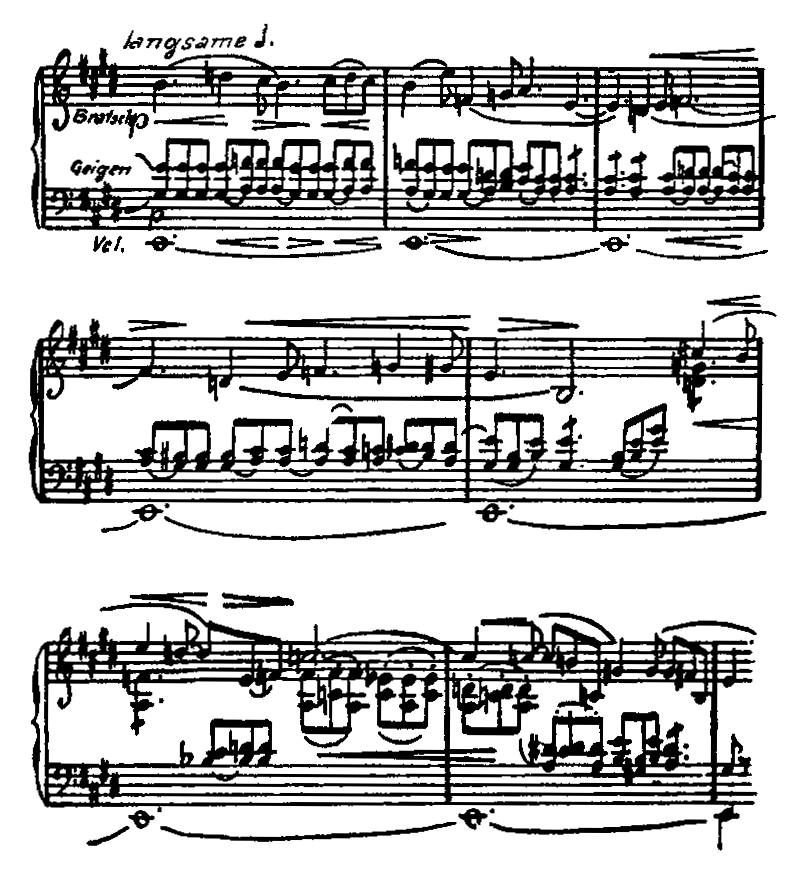
The sonic effect of this quartet is completely new. This has an internal reason first of all: the new melodic and harmonic style of the themes. But then it also has an external reason – the utilization of new sonic possibilities developed in the string section of the modern orchestra: mutes, playing an the bridge, col legno, harmonics, etc. There is no question of external instrumental effects here. These new means of sound are born as a result of the expressiveness of this music. To this must be added the most wonderful utilization of the sounds of the strings and their different ranges.
This quartet had its premiere in Vienna by the Rose Quartet. It was also played by them at the Thirty-Third Composer’s Festival in Dresden, after the resident Petri Quartet had rejected it as “unperformable.”
Then follows the Chamber Symphony in E Major, Op. 9. Schönberg chose the title because of the completely solistic quality and treatment of the instruments, which give it the character of a work of chamber music. At its first and only (!) performance in Vienna by the Rose Quartet and the Wind Instruments’ Association [Bläservereinigung] of the Vienna Court Opera Orchestra, it was also performed without a conductor.
The instrumentation is as follows: 1 flute (alternating with piccolo), 1 oboe (alternating with English horn), one D (also Eb) clarinet, 1 A (also Bb) clarinet, 1 bass clarinet (A and Bb, 1 bassoon, 1 contrabassoon, 2 horns, one first and one second violin, 1 viola, 1 violoncello, one contrabass. Schönberg adds: “Should it be necessary, the strings can also be increased in multiples: (6,6,4,4,3).”
The form of this work is also a fusion of the classical movement types whose sequence is similar to that of the First String Quartet. But the relationships are completely different here. The Chamber Symphony is in essence shorter. It is of a lighter and thoroughly lively character. In comparison to the First Quartet, the thematic artistry is intensified, since Schönberg now works in the same manner with fifteen instruments. Harmonically and melodically the work introduces something quite new: the fourth harmonies and the melodic phrases stemming from the series of fourths. The beginning of the work shows both:
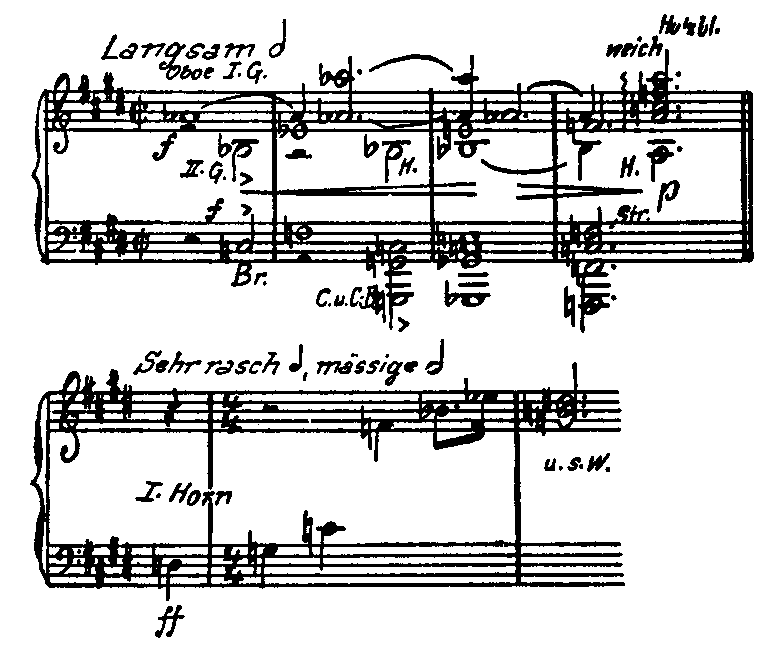
In addition, the whole-tone scale and the harmonies that develop from it achieve enormous significance.
Still greater artistry is found in Schönberg’s treatment of tonality. It is clearly present whenever strived for, but now only in paraphrases and oppositions.
I use as an example the secondary theme of the first main part; while unfolding, it seems not to belong to any key and yet gives the distinct impression of being in A major.
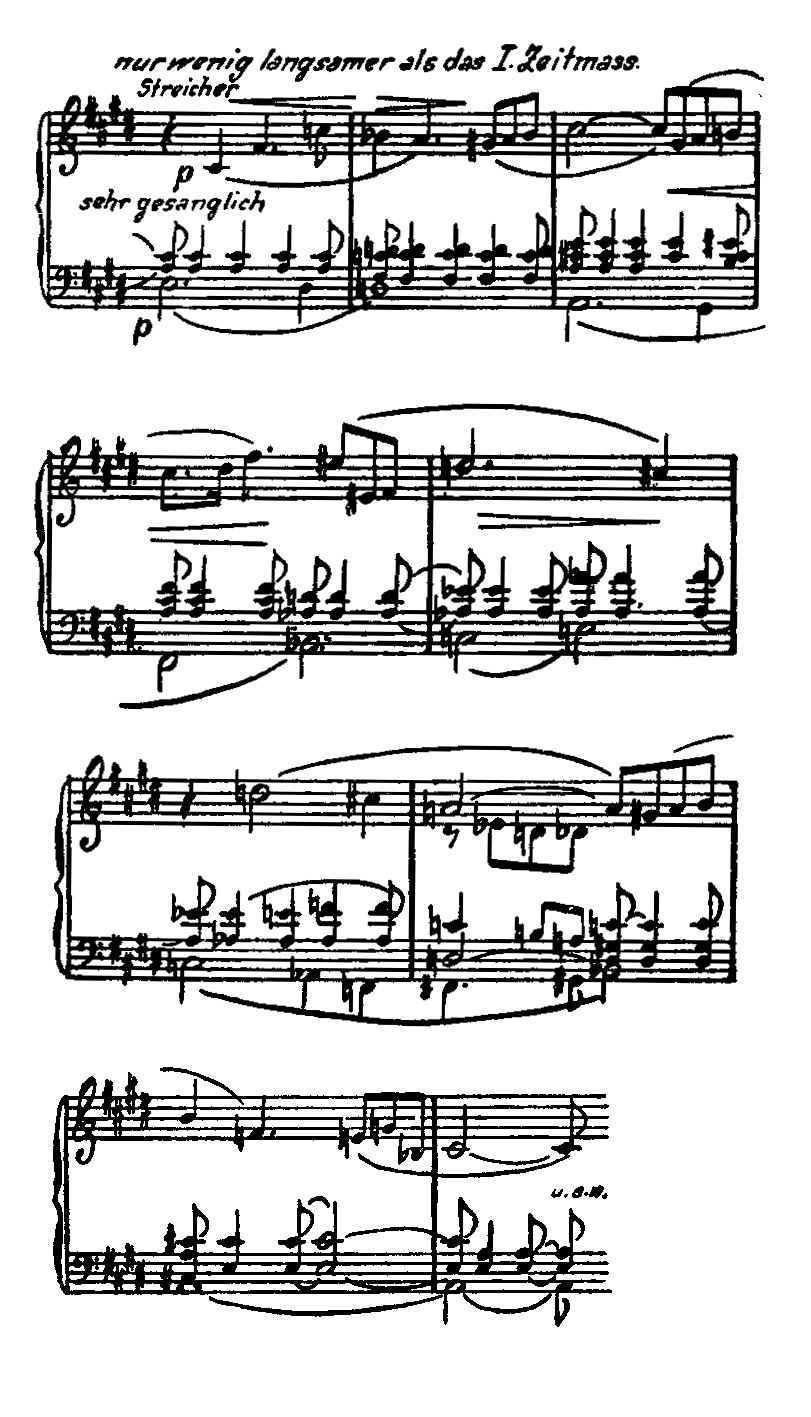
The theme of the slow part offers something similar:
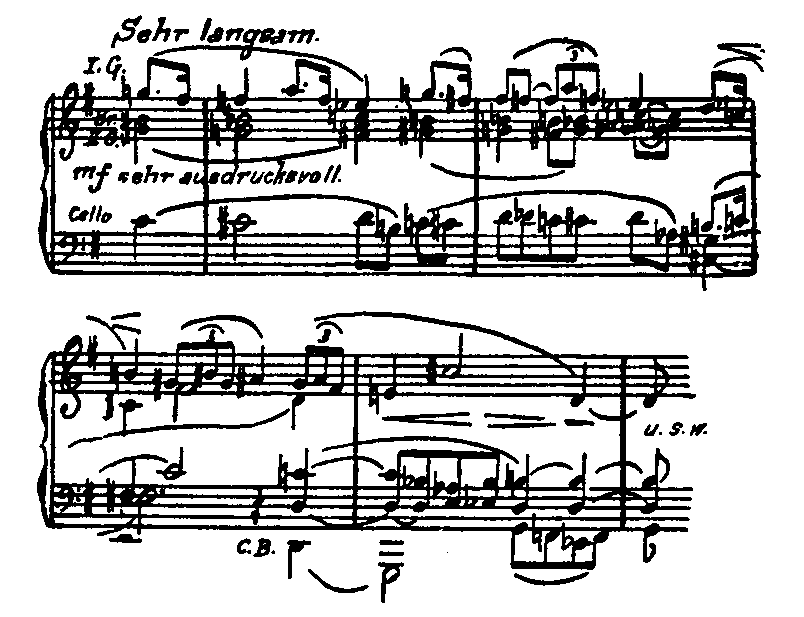
But these examples show very clearly how Schönberg’s music forces itself away from tonality, which is completely undermined by the whole-tone scale, fourth chords and this type of melody.
The Fight Songs, Op. 6, also partake of all these principles. They were composed at approximately the same time as the First Quartet. Often Schönberg’s songs are studies for the revolutionary ideas of the larger works. The songs Op. 6 confront the problem of piano style. The poems are by Hart, Dehmel, Remer, Conradi, Keller, Mackay, Aram, and Nietzsche.
Between the Chamber Symphony and the Second String Quartet is a piece for eight-part mixed chorus a cappella [Friede auf Erden, Op. 13], a work of the most artful polyphony, most wonderful tonal effect, and sublimest expression. The First Performance of this chorus was in December 1911 in Vienna under the direction of Franz Schreker (Philharmonic Chorus). Also written at this time were the Two Ballads for Voice and Piano [Op. 12].
Now to the Second String Quartet (F Minor), with voice in the third and fourth movements.
First movement, moderate; second movement, very fast; third movement, “Litanei”; fourth movement, “Entrückung.” The poems for the movements with voice are from Der siebente Ring by Stefan George.
As previously mentioned, in spite of its four movements this quartet has a formal relationship to Opp. 7 and 9: Here there is also a large, developmental section after the Scherzo, “Litanei.” It is a variation movement, the theme of which is a combination of motives from the first and second movements.
The “model” of the large development in the Chamber Symphony is similarly constructed. The vocal part introduces new motives, which are developed together in the variations. The last movement, “Entrückung,” has no connection to any recognizable instrumental form. It follows the poem freely. With its fragmentary quality and rich alternation of motives, the long instrumental introduction already prepares the way for Schönberg’s later works.
This quartet brings something new to Schönberg’s creative output: brevity. This quality first showed itself in the conciseness of the Chamber Symphony and is clearly evident in the F# Minor Quartet with the division into four shorter movements. It is but a small step from the harmony of this work to the complete abandonment of key. However, the last movement, although belonging mainly in FR major, has no signature. Through alteration the fourth chords change into never-before-heard harmonies that are free from any tonal relationship. A theme from the fourth movement is as follows:
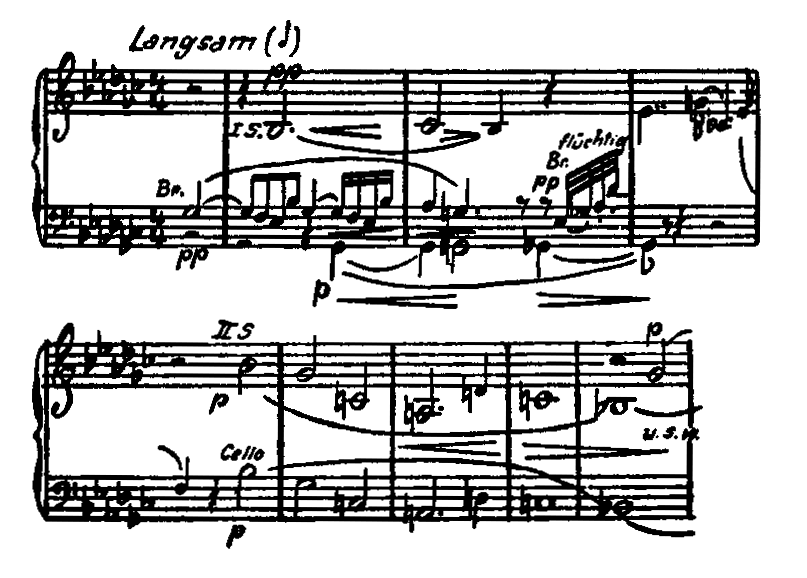
Aehnlich baute Schönberg das »Modell« der grossen Durchführung in der Kammersymphonie. Die Gesangsstimme bringt neue Motive, die in den Variationen mitverarbeitet werden. Der letzte Satz »Entrückung« hat keinen Zusammenhang mit irgendeiner bekannten Instrumentalform. Er folgt frei dem Gedichte. Die lange instrumentale Einleitung bereitet in ihrer Aufgelöstheit und dem reichen Wechsel ihrer Motive bereits die Art der letzten Werke Schönbergs vor.
Dieses Quartett bringt ein neues Moment in Schönbergs Schaffen: die Kürze. Es hat sich schon in der Knappheit der Kammersymphonie angekündigt und spricht sich im Fis-moll-Quartett deutlich in dessen Gliederung in vier kürzere Sätze aus. Von der Harmonik dieses Werkes ist nur ein kleiner Schritt mehr zur vollständigen Aufgabe der Tonart. Der letzte Satz hat auch, obwohl der Hauptsache nach Fis-dur angehörig, keine Vorzeichnung mehr. Durch Alteration werden die Quartenakkorde zu noch nie gehörten Harmonien, die frei von jeder tonalen Beziehung sind. Ein Thema aus dem IV. Satze:
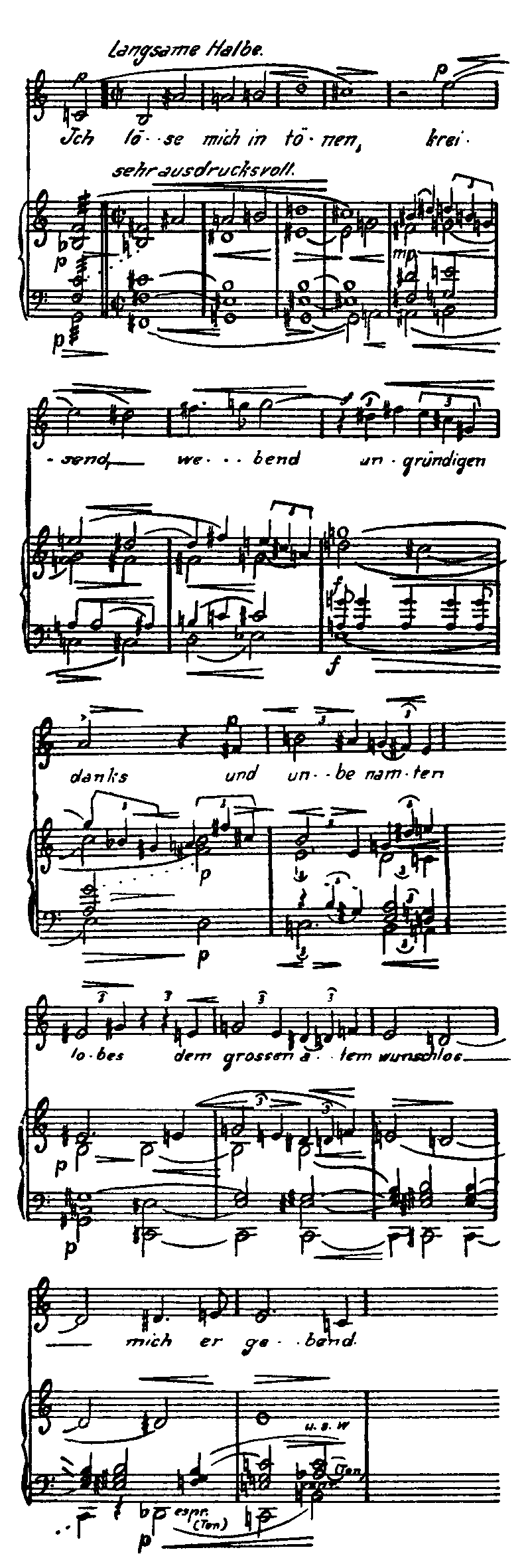
A comparison of this melody with the musical example from the Sextet reveals what sort of development Schönberg’s melodic style has now taken. The inner ear feels the deeper relationship of these melodies. Chromaticism, notes that are dissonant with the accompanying harmony, broad and previously unusual intervals (eg. the major seventh) – these are the exclusive components of this melody.
This quartet was also given its Premiere by Arnold Rose, in December 1908.
All this leads directly to the style of the next work, to the fifteen songs from The Book of the Hanging Gardens by Stefan George.
In January 1910, when the Society for Art and Culture [Verein für Kunst und Kultur] in Vienna sponsored the first performances of Part 1 of Gurrelieder, wich piano accompaniment, the George-Lieder, and the Piano Pieces Op. 11, Schönberg wrote the following preface in the program:
“I composed the Gurrelieder early in 1900, the George songs and piano pieces in 1908. The time between perhaps justifies their great difference in style. Since the combination of such heterogeneous works within the confines of a single concert is a striking expression of one particular person’s will, it, too, perhaps needs a word of justification.
With the George songs I have for the first time succeeded in approaching an ideal of expression and form which has been in my mind for years. Until now, I lacked the strength and confidence to make it a reality. But now that I have set out along this path once and for all, I am conscious of having broken through every restriction of a bygone aesthetic; and though the goal towards which I am striving appears to me a certain one, I am, nonetheless, already feeling the resistance I shall have to overcome; I feel how hotly even the least of temperaments will rise in revolt, and suspect that even those who have so far believed in me will not want to acknowledge the necessary nature of this development.
So it seemed a good thing to point out, by performing the Gurrelieder – which eight years ago were friendless, but today have friends enough – that I am being forced in this direction not because my invention or technique is inadequate, nor because I am uninformed about all the other things the prevailing aesthetics demand, but that I am obeying an inner compulsion, which is stronger than any upbringing: that I am obeying the formative process which, being the natural one to me, is stronger than my artistic education.”
The George-Lieder have to be perfürmed in their totality and in immediate succession. Their relationship is not thematic; yet an inner architectonic design can clearly be felt. Schönberg has created a wholly congruent, highly expressive melodic style, ideally suited to vocal recitation. He also achieves a marvelous wealth of tonal effects for the piano.
The George-Lieder were created in part before the Second Quartet. They fulfilled what had specifically been prepared for harmonically by the works immediately preceding them: key has completely disappeared. But an absolutely compelling necessity keeps watch over this harmonic style.
Schönberg writes about this in his Harmonielehre:
“In composing I make decisions only according to feeling, according to the feeling for form. This tells me what I must write; everything else is excluded. Every chord I put down corresponds to a necessity, to a necessity of my urge to expression; perhaps, however, also to the necessity of an inexorable but unconscious logic in the harmonic structure. I am firmly convinced that logic is present here, too, at least as much so as in the previously cultivated fields of harmony. And as proof of this I can cite the fact that corrections of the inspiration, the idea (Einfall), out of external formal considerations, to which the alert consciousness is only too often disposed, have generally spoiled the idea. This proves to me that the idea was obligatory, that it had necessity, that the harmonies present in it are components of the idea, in which one may change nothing.”
The Three Piano Pieces, Op. 11, follow the songs based on George.
Each of these pieces is short. The first and second have a slight relationship formally to the three-part lied form. The short motives which immediately detach from one another are repeated again and then are spun out further. But even this fetter is removed in the third piece. Schönberg abandons motivic working. No motive is developed further; at the most, a short succession of notes is immediately repeated. Once established, the theme expresses everything it has to say. Again something new has to follow. I demonstrate a section from the first piece, which gives an idea of the individuality of these themes, the combination of motives that are completely oppositional, the richness of this piano writing, and, moreover, the use of a heretofore utterly neglected sound effect from the piano, its harmonic tones.
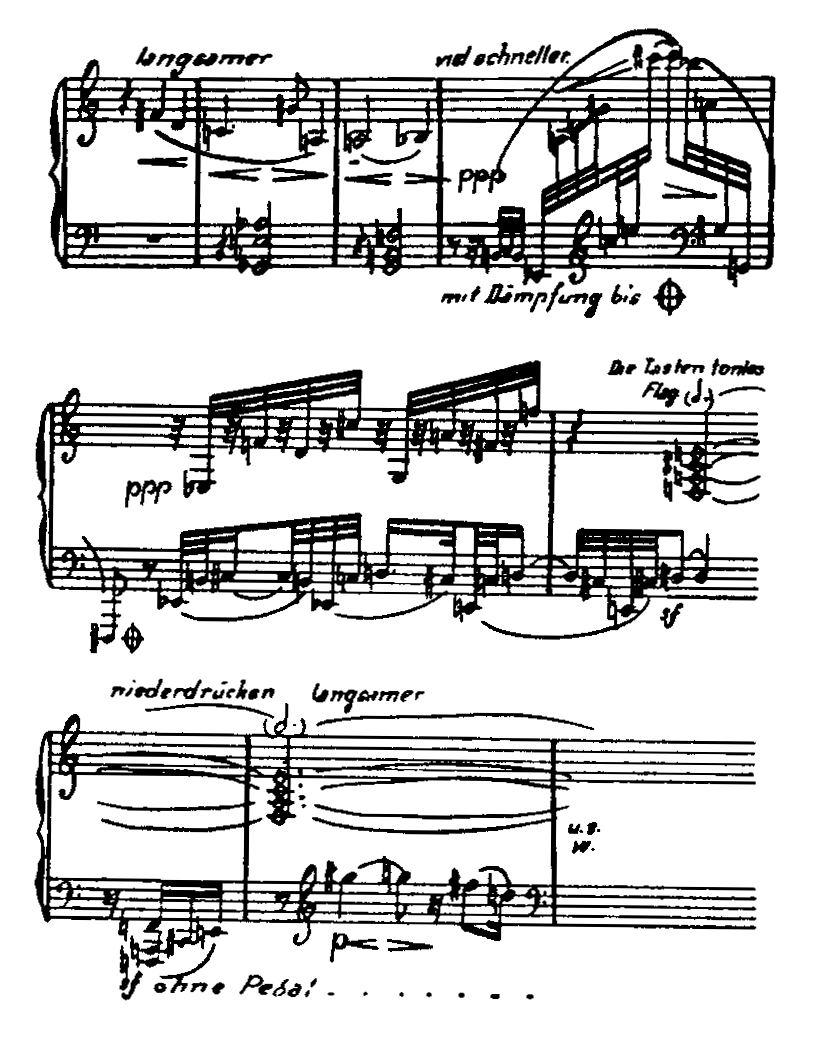
After die Piano Pieces Schönberg composed Five Pieces for Orchestra.
The themes of these pieces are succinct but undergo elaboration. Only in the monodrama Erwartung did Schönberg achieve the abandonment of all thematic work for the first time. There is no trace of any kind of traditional form in the Orchestra Pieces. The form is entirely free. One could perhaps speak of a kind of musical prose here. What Schönberg said with reference to his harmonic style in the passage quoted above from Harmonielehre pertains as well to these forms. Here too an adherence to theoretical principles holds sway. The convincing power of this music vouches for it.
Here is a therne from the second piece:
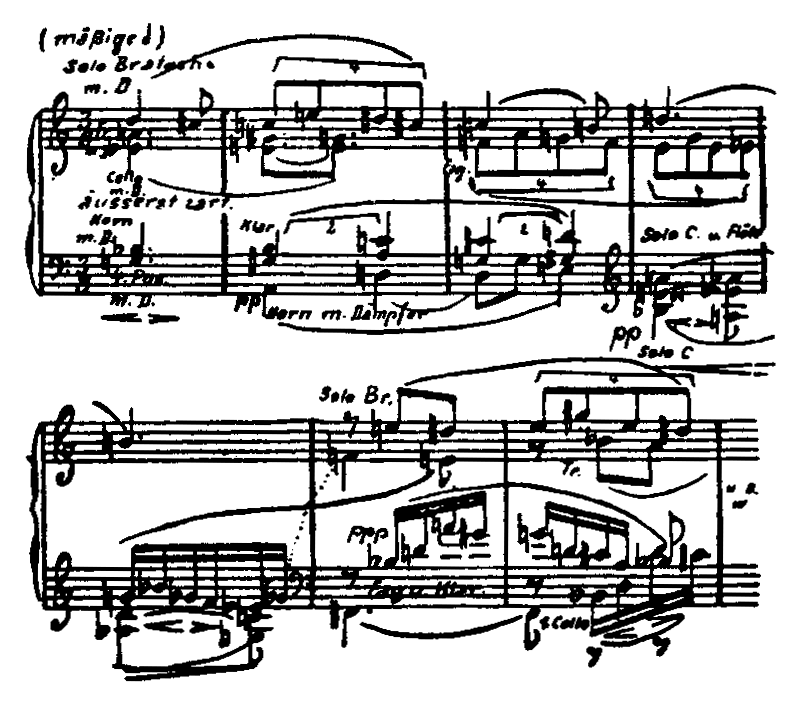
How infinitely delicate is the expression of this theme, how marvelous the linking of the voices. This section also provides a glimpse into the instrumental miracle of this score. How remarkably the first chord is scored. More about this in conjunction with the orchestration of the monodrama.
The third piece offers a completely original sound effect.
The initial measures are as follows:
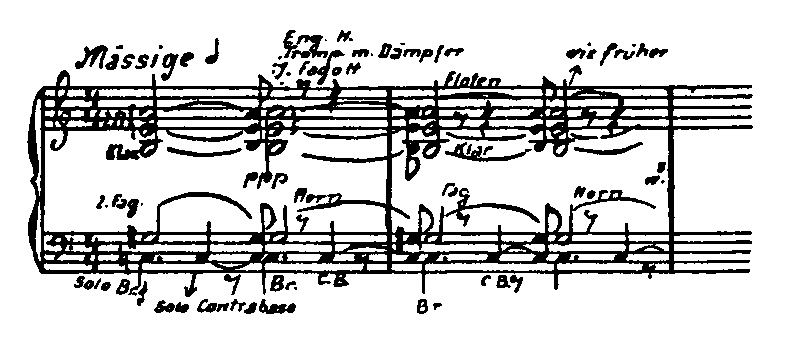
Schönberg remarks: “The chord changes have to occur so gently that no accentuation of the entering instruments is noticeable; the changes should be perceptible only through the different coloration.”
Due to the variation in color of the chords, which extends throughout the entire piece, a characteristically shimmering sound results, comparable, as Schönberg says, to the ever-changing impressions of color in a moderately agitated sea surface.
Immediately following the orchestral pieces, Schönberg wrote his first work for the stage, Erwartung, a monodrama by Marie Pappenheim. A woman is the sole party responsible for an event presented in a series of short transformations connected by brief musical interludes. Late in the evening by the edge of a forest, a woman awaits her lover, searches for him in the forest throughout the night, and at last finds him killed next to the highway as morning dawns.
The work lasts approximately one-half hour. What brevity here, even in a theater work!
The score of this monodrama is an unprecedented event. All traditional formal principles have been severed; there is always something new, presented with the most rapidly shifting expression.
This is also true of the orchestration: a continuous succession of sounds never heard before. There is no measure in the score that doesn’t demonstrate a completely new sound pattern. The treatment of the instruments is entirely soloistic. The registers of the instruments are fully utilized with a marvelous sense of timbre. Schönberg scores chords in a completely new way. An example:
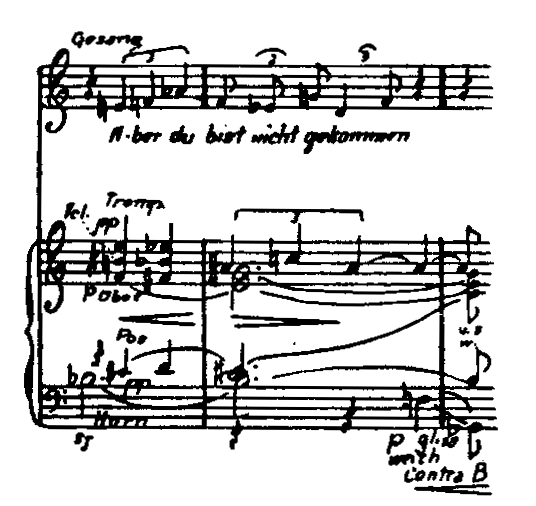
Observe closely the singular compositional technique: the muted trumpet given the highest note, then the solo cello, below that the oboe (!), the muted trombone with the fourth, and the muted horn with the fifth note. In the second measure the contrabass adds a sixth note. Finally, interwoven into the whole is the sound of the vocal part. Each color derives from an entirely different timbral family. There is absolutely no blended sound here; each color resounds solistically, unbroken. But since each is selected so that no note overpowers the next in dynamics, a sonic unity results nevertheless.
The harmonic and melodic style of this work is of an unimagined richness. In it Schönberg constructs eleven – and occasionally even twelve-part chords. Here is an example of an eleven-part chord:
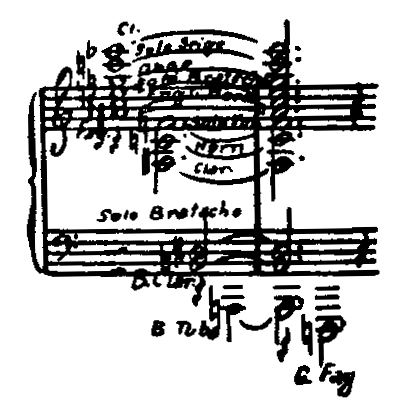
What was said before concerning die instrumentation pertains here as well. I cite the following example in order to illustrate the melodic style of this work and the manner in which Schönberg combines themes:
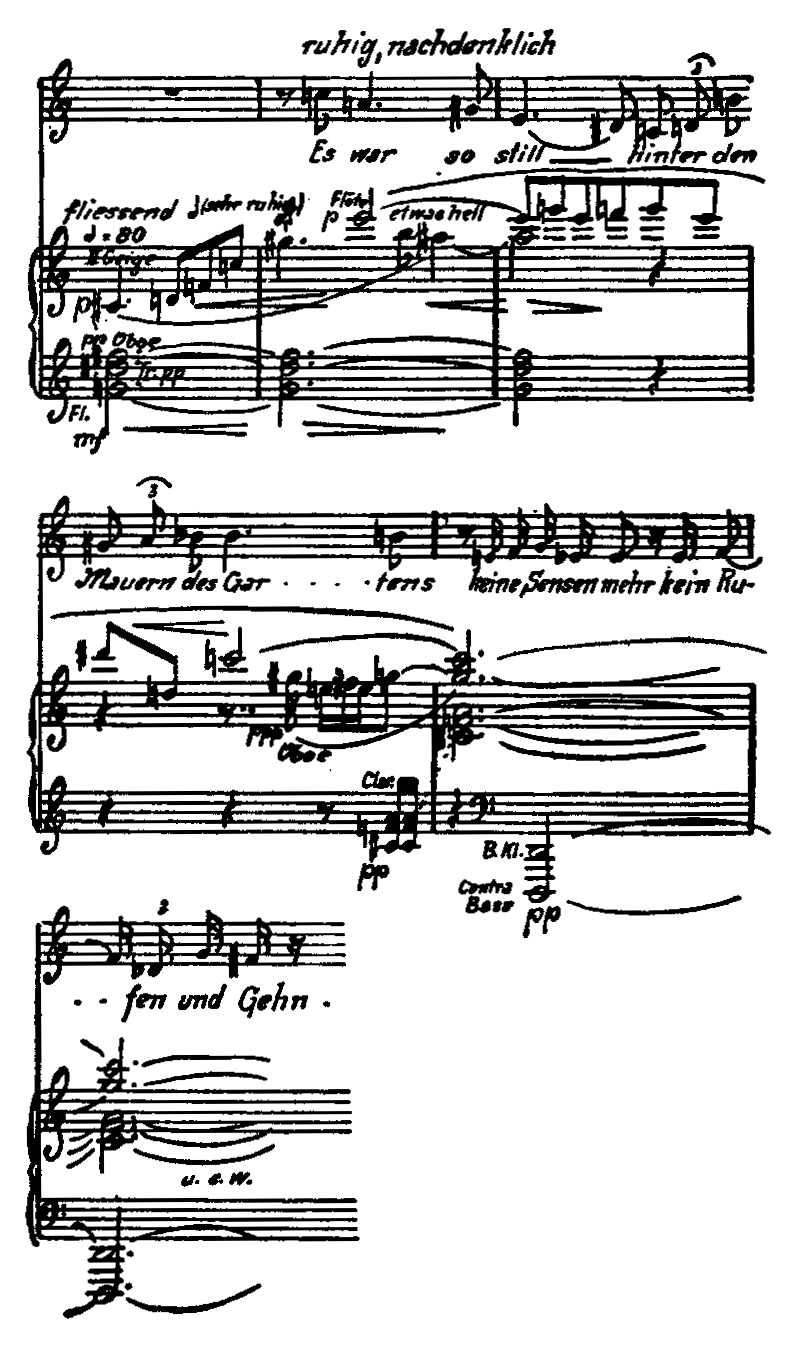
The melody of the second violin is taken over by that of the flute; the vocal line catches hold of' both. In the fifth measure an orchestral chord closes off these melodic phrases; the vocal part, approaching a speaking tone in its expression, continues the sixteenth note movement begun by the entrance of the Oboe in the fourth measure. Thus this music flows by, tightly bound forms along with disintegrating ones, breaking up recitative forms, giving expression to the most hidden and faintest stirrings of emotion.
Now follow six new piano pieces [Op. 19] and the second stagework, Glückliche Hand, drama with music.
The new piano pieces are very short, unbelievably delicate and expressive structures. Say what you will about it, it all is mere lipservice in light of this music. The music of Glückliche Hand is still incomplete. The poem of this work is by Schönberg himself. It appeared in volume 17 (2nd year) of the Viennese musical journal Der Merker, devoted to Schönberg.
What I have attempted to show is the relentless necessity with which everything in Schönberg’s creative work is accomplished.
Those who devote themselves lovingly to this work must recognize this. Only those blinded by envy and ill-will could speak of “sensationalism mania” and the like. Since such assertions impede the influence of Schönberg’s work, they must be eradicated. But as for the work itself, no harm can come to it: it is beyond the realm of time.
Arnold Schönberg. Mit Beiträgen von Alban Berg et al. München 1912, 22–48
